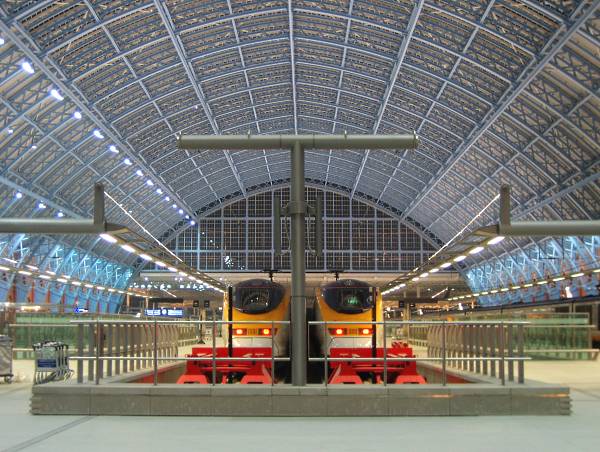Given there are magazines for just about every topic under the sun, I suppose you can tell a lot about a person’s interests from which ones they buy. A lot of those that I buy (or subscribe to) are pretty geeky.
But I don’t normally buy railway-related magazines. Many of them I find overly-gunzelly, which is not my thing. But I will admit to last week buying the November 2007 edition of Modern Railways, the British-based magazine which was featuring the new High Speed 1 link from the English Channel to London, which means now you can travel from London to Paris by train in just over two hours.
Looking at some of the pictures, one can understand why engineers enjoy what they do. It’s as close to sexy as inanimate objects get… sweeping curves, sleek rails and wires, impressively huge bridges and viaducts, and the graceful arched roof of the renovated St Pancras station.
And then there’s the trains. They rocket along at 300 kmh. Makes our 160 kmh V/Locity trains look slow. Even the very zippy UK east coast train to Scotland I rode in 1998 crawls along in comparison at a mere 200 kmh.
This kind of high-speed rail service would be nice to see in Australia, but probably isn’t cost-effective — it would cost billions and billions to build, and Melbourne to Sydney is perhaps just a bit too far for it to be competitive with air… though the TGV record is 574.8 km/h, so theoretically the trip could be just a few hours.
There are many other higher priorities, particularly in urban rail.
But it’s nice to see others are able to build these kinds of super-fast super-efficient (and carbon neutral) railways. Next time if/when I get to Europe, I’ll certainly be taking a spin on it.
Now, if only we could get all the engineers currently employed on building roads to build new rail lines instead. They’re doing it in Perth, but alas, not here.

9 replies on “Sleek, sweeping curves”
I wonder what European enthusiasts think of our Spencer St, sorry, Southern Cross station.
Daniel
unfortunately, the Channel Tunnel isn’t cost effective either. The project has always been in massive (and growing) debt. This is despite the huge cost of tickets to use the thing. A bit like Concorde. A great piece of engineering, but not commercially viable without government bail-outs.
Rog.
I would much rather catch a TGV between Melbourne and Sydney than fly. It would be a three hour trip, station to station. At each end (Spencer St and Sydney Central?), a short walk would have you in the middle of the CBD. Quicker check-in, more comfortable travel and the ability to use a computer or whatever other equipment one desires, while in the train. It’s far better than air travel.
All we need is for the cost of jet fuel to go up and train travel will be ‘commercially viable’, as air travel apparently is.
Does commercial viability still matter when there’s no oil left with which to make jet fuel?
By the way, it’s not the Eurostar that makes Victoria’s country trains look slow. Car travel does that. A train that does 160 km/h for a few minutes of a two-hour journey isn’t a high speed train by any definition.
Bring on the fully electrified network in victoria. It’s so annoying that they don’t electrify at least all the way to geelong. still can’t believe that.
By the way has anyone noticed that connex are recruiting trains drivers? Anyone got any ideas what they get paid? It’d be a bit of a seachange for me at least :)
Even at 300km/h, those trains aren’t that fast if you compare them to the Japanese “Maglev” trains. Those things can rocket around up to 581km/h.. Remind me why we’re still stuck on these dodgy Australian tin cans again..
There’s a sweet spot for speed and cost, and Maglev isn’t it. It’s ludicrously expensive, and totally incompatible with existing railways. Not to mention that there are barely any actual installed commercial Maglevs… just one in China I think. If you’re going to go for high speed rail, you might as well go TGV-style, to keep it compatible with track you already have.
Nathan, apply here!
The TGV has managed around 580 km/h anyway, and both it and Maglev can maintain the same cruising speeds. The Maglev trains won’t do 581 km/h usually. That was just a record.
LOL have sent an email to the recruitment company. I’m in two minds… one major problem for me is that I’ve sold my car. It would be very ironic becoming a train driver and having to drive a car to work, it’s the one major thing that puts me off. Though I am bike ride distance from Camberwell and can virtually walk to the Burnley Sidings :)
The Chinese maglev is an interesting ride but not at all profitable – just a way for the Chinese Government to prove how sophisticated they are really … mind you, screaming along at 400kmh+ (briefly 460kmh at our top speed) really does eat up the 28km or so between the airport and the outskirts of the city in about 6min, but totally, totally impractical …
not to mention the obscene number of guards at both stations in very obviously ceremonial uniforms saluting the train as it came to a stop, x-ray machines, bag searches, etc etc … oh, and the ‘poverty barriers’ which we noticed when getting back to the Shanghai end of the line, ostensibly to cut down on noise but more likely placed so as to not offend the sensibilities of any visiting dignitories … feh
Amanda and I were at St Pancras a few months back while it was still under construction and it looked pretty spectacular even then … and yes, the UK train we took between London and Newark made our intercity trains look like so much limp celery in comparison …